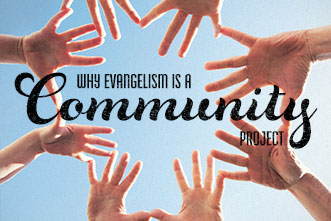What do you think of when someone says the word “evangelism”?
For many Christians, it conjures up images of awkward conversations and one-size-fits-all gospel presentations.
But a closer inspection of the Bible reveals a different picture.
Our collective witness.
I recently had the privilege of gathering with my church small group to discuss the topic of evangelism and “missional living.” As a group, we wanted to become better equipped to engage our community, neighborhoods, workplaces, schools and families with the good news of Jesus Christ.
So we invited one of our assistant pastors, who is gifted as an evangelist, and his wife to come and share their experiences with us. Although they had several suggestions that individuals could take, many of their ideas had to do with what we could do as a group.
This reminded me of the power of our collective witness as believers.
Collective evangelism in Acts 2.
In the Bible, Acts 2 is perhaps the best illustration of collective evangelism.
Verses 1-4 explain that the Holy Spirit descended not on an individual, but on an entire house full of people (cf. Joel 2:28). Then this group of believers began speaking in tongues so that the diverse people of Jerusalem were all hearing them speak in his or her own language (Acts 2:8). Then the Apostle Peter gives a Spirit-filled sermon resulting in the conversion of 3,000 people that day (vv 14-41).
While Peter served as the mouthpiece in this particular instance, the next several verses show that conversion and discipleship still occurred within the context of community.
Acts 42-47 describes the early church. After 3,000 people repented of their efforts at self-salvation and believed in Jesus Christ, they gathered in communities. Verse 42 describes their practice as the gathered people of God. They studied the teachings about Jesus, they enjoyed fellowship with other Christians, they shared meals together and prayed with each other. They also sold their possessions and gave to anyone among them that had a need (vv 44-45). In short, the new believers in Acts became a new community and lived out that new life in acts of love and worship.
What was the result of the believers in Acts living as a Christian community?
People were converted. Acts 2:47 says they were “praising God and having favor with all the people. And the Lord added to their number day by day those who were being saved.”
The Christian way of sharing life together gave them “favor with all the people.” Outsiders saw the sacrifices and joy the Christians displayed, and they were attracted to this way of life. Then they began to investigate who these Christians were and what they believed (or rather in whom they believed) to make them spend all their time with other Christians and even sell their belongings.
When they actually began to experience Christian community, they came to believe in the One who makes Christian community possible … Jesus Christ.












